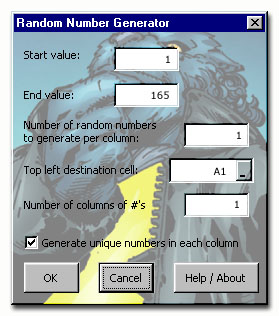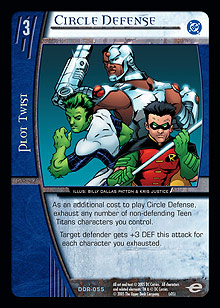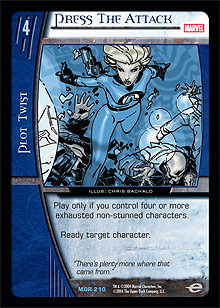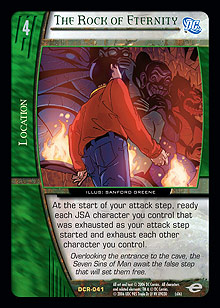
I’ve been writing articles for Metagame.com for a little over a year now. For the most part, the feedback I get on those articles is positive . . . even praising. The decks that I come up with may not win any Pro Circuits, but they are usually fun, interesting, and unique.
Unique . . . well, that’s not always true. I do occasionally get feedback where a reader thinks that one of my deck ideas has already received its fair share of attention. For example, my Doom article from a few weeks back was admittedly a spin on an already existing idea to use Crisis on Infinite Earths to make the different versions of the good doctor non-unique. For the most part, it was a teched-out update to incorporate the newer versions of Doom in the Heralds of Galactus set.
While I try to be innovative with my ideas—building decks with themes that have not been effectively explored—I do occasionally trip over the lines that other people have drawn. Still, considering that I’ve built over 40 different decks now, I must say that I think I’ve done a decent job featuring different deck ideas and themes.
This was true, at least, until this week. This week, I had no idea whatsoever what to write about!
The Creative Process (revised)
 While I have a few deck ideas sitting on the back burner, I really had no idea what to write about this week. I’ve featured almost every team from the Heralds of Galactus set (with the notable exception of the Kree, who you should see next week). After I’ve explored the deck possibilities with teams from the newer sets, I usually start to run low on inspiration for article material, but it has never been quite as bad as this time around.
While I have a few deck ideas sitting on the back burner, I really had no idea what to write about this week. I’ve featured almost every team from the Heralds of Galactus set (with the notable exception of the Kree, who you should see next week). After I’ve explored the deck possibilities with teams from the newer sets, I usually start to run low on inspiration for article material, but it has never been quite as bad as this time around.
After several hours of indecision, I decided to take a different approach to my selection process and try a little random selection. I created a couple of random number generators in Microsoft Excel. The first was 1 through 11, representing the sets that have been released for Vs. System to date. This yielded a 2: DC Origins. The next random number was for 1 through 165, representing the number of cards in DC Origins. This number was 55. This is how I came up with DOR-55: Circle Defense.
Circle Defense? I don’t even remember what that does! Let’s see . . . 3-cost plot twist . . . target defender gets +3 DEF for each non-defending Teen Titans character you exhaust . . .
Holy cow! +3 DEF? I seem to remember that people thought Deflection was a pretty good defensive card at +1 DEF for each character exhausted. This is literally three times better! Granted, it’s team-stamped to the Titans, but how did I miss this?
 Oh yeah . . . I know how. Standard Teen Titans builds are more slanted towards aggressive initiatives and using combat tricks like Terra and Roy Harper ◊ Arsenal, Sharpshooter on off-initiative turns. Thus, defensive pumps are not very common in Titans builds, as most people would rather exhaust their characters to give Arsenal +2 ATK than for Circle Defense. That’s a real shame, too, as Circle Defense seems like a really good card otherwise.
Oh yeah . . . I know how. Standard Teen Titans builds are more slanted towards aggressive initiatives and using combat tricks like Terra and Roy Harper ◊ Arsenal, Sharpshooter on off-initiative turns. Thus, defensive pumps are not very common in Titans builds, as most people would rather exhaust their characters to give Arsenal +2 ATK than for Circle Defense. That’s a real shame, too, as Circle Defense seems like a really good card otherwise.
There must be a way that we can make the most out of such a potent defensive pump. Wasn’t there a team in Infinite Crisis that had some sort of exhaustion theme going on? Oh, yeah—it was JSA! In fact, I did an article on The Rock of Eternity a few months back. I even said that Arsenal would be a great card to facilitate the JSA exhaustion theme in the deck. Well, it certainly seems like this might be a viable fit for Circle Defense.
Like I said earlier, I may not be building the next PC-winning deck. Still, I think that we could have a lot of fun abusing the exhaustion synergies between the Teen Titans and JSA. And the featured card will be none other than the totally random Circle Defense!
The Build
Four copies of the featured card, Circle Defense, seems like a good way to start off the build. Of course, we will need to have a way to team-up our two DC teams. Given the overarching exhaustion theme that we’re shooting for here, Allied Against the Dark seems like a strong choice for our build. We already know that we’ll be exhausting characters to give them a healthy DEF boost, so we might as well throw in a Team-Up that assists their ATK. Of course, we need to keep in mind that four copies of our Team-Up may not be enough to ensure that we find it in a timely fashion. Considering that the most powerful cards for both teams are heavily team-stamped, we need a little more assurance that we’ll hit our all-important Team-Up, so we’ll also include two copies of Teamwork. In addition to finding our Team-Up card for us, Teamwork also helps to protect our valuable Team-Ups from nasty, opposing plot twist effects.
 Of course, what would any Teen Titans deck be without four copies of the infamous Press the Attack? Indeed, having effects that can exhaust your own characters can be quite helpful, especially if you have a powerful plot twist like Press the Attack that requires having four exhausted characters in play. Press the Attack can give us another attack with a large character, or possibly another activation of Arsenal to stun yet another opposing character. With the exhaustion methods available to us, Press the Attack will be a valuable aid in making the most of our characters in play.
Of course, what would any Teen Titans deck be without four copies of the infamous Press the Attack? Indeed, having effects that can exhaust your own characters can be quite helpful, especially if you have a powerful plot twist like Press the Attack that requires having four exhausted characters in play. Press the Attack can give us another attack with a large character, or possibly another activation of Arsenal to stun yet another opposing character. With the exhaustion methods available to us, Press the Attack will be a valuable aid in making the most of our characters in play.
While our deck does feature a potentially powerful plot twist, there will definitely be times where we won’t be able to get a key character large enough to bounce an attack. In this case, we might be forced to have one of our smaller characters “take one for the team.” Thus, a couple of copies of Heroic Sacrifice will find their way into our build. It’s always a shame when we’re forced to stun our characters, but it’s almost always better to lose a small character than one of our more important, large characters.
Our final plot twist is our character searcher. We might be able to use Optitron, much the way that standard Titans decks do, to provide for our character search needs. The resource point payment requirement, however, is really only useful in early turns lest we be forced to underdrop on critical turns. Thus, we will go with our standby of Enemy of My Enemy for searching out our key characters.
Location choice will be critical for our deck, as much of the power will come from these locations. First up is the aforementioned The Rock of Eternity. This location does have the potential to wreck our plans, as we could be forced to exhaust all of our characters before we could ever attack with them. In the right deck, however, we can reap the benefits of exhausting our characters for various effects, then have them ready once again to lay the beats on our opponent. Indeed, effects that ready characters are still among the most powerful in the game.
As great as readying characters can be, though, we still need something in the way of raw attack power. Fortunately, the Teen Titans have one of the best ATK boosting locations in Titans Tower. I still recall my embarrassment as Neil Reeves asked me why I passed a copy of Titans Tower in the first draft pod at the very first Pro Circuit. Indeed, the power to give a character extra ATK while attacking or defending is quite potent. With Circle Defense in the mix, it would certainly be possible for us to bounce an opposing attack, then boost our character’s ATK to force the stun on our opponent’s attacker. The bottom line is that any reusable ATK boost is definitely one that we want for our deck.
Our last location is a Teen Titans standard for cycling through decks. USS Argus appears to be a bad trade, forcing us to skip our draw phase. However, the ability to view four extra cards each turn (and consequently keep one of those cards) is one that gives us an edge. Granted, we may lose out on hand advantage, as the trade-off of two cards for one can whittle our hand down quickly. But the tactical advantage achieved is considerable enough for us to want to play USS Argus. Besides, with resource removal effects like Terra and Arsenal, we may not end up skipping too many draw phases anyway.
Some of our character choices may be rather apparent. Others, like the deceptively powerful 1-drop Roy Harper ◊ Speedy, may be a bit less obvious. In most games, our Mercurial Marksman will not see play. Against off-curve and combo decks, though, Speedy is more powerful than the largest drops in the deck. The ability to KO 1-drops can be very important when we need to break through a Child Lock. Speedy may be tech, but he’s a part of the best tech in the game.
Our other 1-drop rolls us into our 2-drop. Ironically, we probably won’t play either Dawn Granger ◊ Dove or Hank Hall ◊ Hawk before turn 3. Still, the amazing boost effect of Hawk and Dove allows either one to find his or her counterpart from anywhere in the deck and bring that character into play. More importantly, Dove and Hawk give each other a notable stat boost when they are in play together. Getting a 1- and 2-drop in play that are the size of 2- and 3-drops, respectively, is quite a good deal.
Still, we must have 2-drops on occasion to help us through the early turns before we recruit Dove and Hawk. This, of course, is why we need at least a couple of copies of Tim Drake ◊ Robin, The Boy Wonder. Robin has dual utility in our deck. He is a fine play early because he can redirect stuns on our team attacks to our less vital characters. Of course, Robin can be an even better play in later turns, when his boost gives our characters the ability to attack without fear of stunning back. However, Robin is our backup at 2; who we’d really like to have is Kate Spencer ◊ Manhunter. Manhunter is a beast in off-curve combat, giving a bonus to all of our characters attacking up the curve. In addition, Manhunter can wreck the best-laid plans of opposing hidden characters, as she can enable a character to attack a larger character in the hidden area. We usually won’t have any problem finding enough attack pumps to enable our smaller characters to swing up the curve. Characters with concealed beware: Manhunter will find you. I guess no man does escape the Manhunters!
Our 3-drops kick off with the mighty, mighty Roy Harper ◊ Arsenal, Sharpshooter. I don’t really need to go into much detail as to why Arsenal is such a powerful card. If you have any knowledge or understanding of Teen Titans characters, you’ll already know that Arsenal can absolutely dominate a game. In a deck where we prefer to exhaust our characters before we move into our attack step, Arsenal could be even more devastating. Who’d have thought it possible? Another 3-drop with the potential to control games is Michael Holt ◊ Mr. Terrific. Mr. Terrific gives a bonus to all of our characters who are exhausted and in combat with larger characters. Will our characters be exhausted a great deal of the time? Yes. Thus, our opponents will be given the difficult choice of attacking laterally along the curve—and in all probability, suffering a stunback—or attacking down the curve and, in all probability, suffering a stunback. The bonus while we are attacking almost seems understated, as Titans have always excelled at attacking successfully up the curve. Still, an extra +2 ATK / +2 DEF never hurts.
Turn 4 is going to seem a bit bizarre to many people. Still, the choices should be well-understood after a bit of explanation. Contrary to what you may have guessed, Terra is our backup 4-drop. Yes, she is great at stunning 3-drops, and her synergy with USS Argus is undeniable. Still, she is fairly small by current standards. At the very least, we’d like to have an average-sized character with a relevant ability. Sand meets those criteria to a “T”. He has an extra point of ATK to make sure that he is usually able to stun opposing 4-drops, but it’s his effect that we’re really interested in. Considering that we’ll have a great deal of control over whether or not our characters are exhausted, we can arrange our turns so that Sand only becomes stunned while we have no ready characters. Unless our opponent has a KO effect like Finishing Move, we can almost ensure that Sand will never leave play. Now that is a powerful board control tool!
 If there were ever a more obvious pick on turn 5, I don’t know what it is. Both teams have some awesome 5-drops, but Garth ◊ Tempest is where it’s at. Recursion is a powerful effect, and there simply isn’t a better recursion effect than the one Tempest boasts. If we are forced to discard a character that we would like to play in later turns, Tempest can get it back. If we need to retrieve a copy of USS Argus from the KO’d pile for the next turn, Tempest can get it back. If we’d like to reuse a copy of a combat trick like Press the Attack that is currently sitting in the KO’d pile, Tempest can get it back. Sorry Hulk Hogan, but the simple truth is that Garth rules!
If there were ever a more obvious pick on turn 5, I don’t know what it is. Both teams have some awesome 5-drops, but Garth ◊ Tempest is where it’s at. Recursion is a powerful effect, and there simply isn’t a better recursion effect than the one Tempest boasts. If we are forced to discard a character that we would like to play in later turns, Tempest can get it back. If we need to retrieve a copy of USS Argus from the KO’d pile for the next turn, Tempest can get it back. If we’d like to reuse a copy of a combat trick like Press the Attack that is currently sitting in the KO’d pile, Tempest can get it back. Sorry Hulk Hogan, but the simple truth is that Garth rules!
Usually on turn 6, we would prefer to underdrop for a game-ending onslaught with our small, powerful characters. However, we may occasionally want to follow the curve. In this situation, we have a copy of Connor Kent ◊ Superboy, Tactile Telekinetic. There is nothing that isn’t good about Superboy in our deck. He possesses yet another effect that facilitates the exhaustion theme. In addition, he can be a trump card when dealing with decks that lean heavily on equipment cards. (I hear that the Fate Artifacts are popular nowadays.) Even if we never recruit Superboy, he makes a decent discard for Titans Tower. Put simply, Superboy is a fine fit for the deck.
Finally, at 7, we have The Phantom Stranger, Wandering Hero. In most games, we won’t ever want to recruit our 7-drop—so why are we playing two copies? Because he’s amazing! We discussed earlier how powerful recursion is in Vs. System. Here we have a card that not only has a very impressive recursion effect, but also facilitates our exhaustion theme. Given this, we might tend to overlook the fact that The Phantom Stranger has a relevant power-up effect that we can utilize. However, we might want to look past that and consider that The Phantom Stranger could be absolutely amazing when used in unison with Titans Tower. With The Phantom Stranger’s recursion effect, Titans Tower really is a reusable +7 ATK boost.
Whew! I’m worn out!* Let’s take a look at what our random sampling has yielded.
Random Exhaustion (60 cards)
Characters (29)
2 Dawn Granger ◊ Dove, Agent of Order
1 Roy Harper ◊ Speedy, Mercurial Marksman
4 Kate Spencer ◊ Manhunter, Fearless Renegade
2 Tim Drake ◊ Robin, The Boy Wonder
2 Hank Hall ◊ Hawk, Agent of Chaos
2 Michael Holt ◊ Mr. Terrific, Renaissance Man
4 Roy Harper ◊ Arsenal, Sharpshooter
4 Sand, Sanderson Hawkins
1 Terra, Tara Markov
4 Garth ◊ Tempest, Atlantean Sorcerer
1 Connor Kent ◊ Superboy, Tactile Telekinetic
2 The Phantom Stranger, Wandering Hero
Plot Twists (20)
4 Allied Against the Dark, Team-Up
4 Circle Defense
4 Enemy of My Enemy
4 Press the Attack
2 Teamwork
2 Heroic Sacrifice
Locations (11)
4 The Rock of Eternity
4 Titans Tower
3 USS Argus
 It’s kind of hard to say what the mulligan in the deck is, as Teen Titans decks historically have a tendency to right themselves rather quickly. It would be difficult to mulligan any hand with The Rock of Eternity, but it is much more important for the deck to hit its drops. Basically, you should look for a solid early curve, with cards like Enemy of My Enemy and USS Argus to help you hit your later drops.
It’s kind of hard to say what the mulligan in the deck is, as Teen Titans decks historically have a tendency to right themselves rather quickly. It would be difficult to mulligan any hand with The Rock of Eternity, but it is much more important for the deck to hit its drops. Basically, you should look for a solid early curve, with cards like Enemy of My Enemy and USS Argus to help you hit your later drops.
The initiative preference may be a bit different than a standard Titans deck, as Sand is your primary 4-drop. The deck certainly has the power to kill on turn 5 or 6, so the initiative choice may be largely inconsequential. Evens may be a better call, as turn 1 you usually won’t have a 1-drop, and turn 6 is a great point to underdrop smaller characters like Arsenal and Michael Holt for a game-ending assault.
And that’s all. It’s good to see that this experiment in complete and total randomness yielded something that is actually playable. Be sure to check back next week on Breaking Ground as we take a look at the possibilities for the Kree resource disruption theme—something a bit more planned, to say the least . . . heh heh!
*Get it? An exhaustion joke!!!
Michael Barnes (AKA BigSpooky) is an avid Vs. System player who is a founding member of Team Alternate Win Condition (TAWC). When he isn’t concocting crazy deck ideas that no sane person would think of, he occupies his spare time working as an accountant in Dallas, TX. Any questions, comments, suggestions, or random thoughts that you might have for Michael can be sent to him at BigSpooky1@hotmail.com.